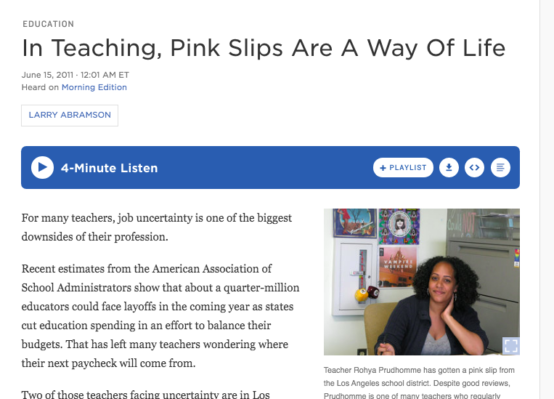How to cover a complicated, emotionally charged process in which solid information can be hard to get.
By Chad Aldeman
Even in a normal year, it can be challenging to cover the teacher hiring process.
School districts project their student enrollment for the coming year and use those estimates to decide how many teachers they’ll need at each school. After subtracting teacher turnover and retirements, districts then hire to fill any remaining spots.
This summer is, of course, far from normal.
As school districts begin to announce their plans for the fall without clarity on how many students are likely to enroll or whether teachers will return to schools, reporters will need to help readers understand what choices districts are facing and what their decisions will mean for teachers and other education employees.
Budget uncertainties will make reporters’ jobs even harder as they attempt to explain potentially misleading terms like pink slips, layoffs, and RIFs (reductions-in-force). Most challenging of all, reporters will also have to try to determine how all these decisions will affect the quality of services students receive.
To help journalists wade through all that murkiness, I’ve identified five tips for reporters to produce smart, accurate journalism about the layoff process.
1: A pink slip is not a layoff
Many states require notices to be sent to any teacher who may face a layoff in the year ahead, but this doesn’t mean their job loss is guaranteed. Those rules, in turn, force districts to overidentify workers who might be at risk. Without careful reporting, the public perception of layoffs may be larger than the eventual impact.
A 2015 study, for example, looked at these RIF notices in Los Angeles Unified School District and across the entire state of Washington. The researchers found that Los Angeles notified three times as many teachers that they might be laid off as those who were actually let go. Across Washington state, districts sent about six times as many RIF notices as teachers who were eventually let go.
This phenomenon is already happening today. For example, a recent Boston Herald article about pink slip notices didn’t mention until the last sentence that “districts could and often do recall some of the staff who received pink slips.” A recent Boston Globe article did slightly better, alerting readers that state law required districts to notify teachers by June 15 whether their positions might be cut. A 2011 NPR story shows how to give the broader context. Rather than simply focusing on the immediate numbers, it tells the stories of individual teachers who received a pink slip from their district year after year.
That context is important because while pink slip laws may help individual teachers plan, they also do long-term harm. The study mentioned above found that in both Los Angeles and across Washington state, the threat of potential layoffs, even for teachers who did not personally receive a RIF notice but who were surrounded by peers who did, made it more likely that teachers would choose to leave their schools in the years following.
2: Not all layoff plans are the same
Reporters owe it to readers to unpack how district contracts affect their decisions about which employees to let go and which jobs need to be refilled.
Are districts using all of the tools available to them to make their decisions? Are they sending out pink slips simply based on seniority via a last-in, first-out formula, or are they capturing teacher performance or district needs in some way? And what are the results of those decisions? Are most of the layoffs going to be concentrated in low-income schools or is the district taking steps to protect those schools from added instability?
Help your readers by finding out who receives a layoff notice and where they are concentrated. Research suggests that seniority-based layoffs force districts to cut more employees than they otherwise would, and relying on seniority alone can lead districts to lose some of their best teachers. Moreover, seniority-based layoffs tend to fall heaviest on low-income schools with high concentrations of newer teachers.
Rather than simply reporting the total numbers of layoff notices, reporters should ask districts for details on how decisions were made, and then explain to readers how those decisions will impact schools in their district.
For example, a recent WBUR story on pink slip notices in Brookline, Massachusetts, focused on how they will harm the district’s efforts to diversify its teaching workforce.
3: Be careful about how you report survey results
There are a variety of surveys purporting to show how teachers feel and are going to behave. Reporters should ignore most of these, or at least present them with the appropriate caveats.
For example, I’ve seen a number of surveys in recent weeks with decent sample sizes, but they don’t claim to be representative of the larger population and so shouldn’t be presented as such.
Even for the surveys that do claim to be representative, reporters should look carefully at the wording of the questions and the demographics of the participants. Before covering the findings, reporters should check to see if the demographics of the respondents align at least somewhat with the broader teacher workforce.
Moreover, surveys are capturing people’s thoughts at a moment in time. It’s much better to report on hard numbers than to speculate based on survey results.
For example, a recent USA Today/Ipsos poll found that 18 percent of teachers would leave their jobs if schools were to reopen, including 25 percent of teachers over the age of 55. But rather than repeating those findings, Arizona Republic reporter Lily Altavena emailed her state’s teacher pension plan for recent retirement application numbers and found no significant increases in teacher retirements across Arizona so far.
This story is likely to evolve over the summer as district plans become public and teachers make their own decisions, but Altavena’s strategy is a good one. State- and city-run teacher pensions publicly report teacher retirement figures in their annual financial reports. It’s easy to find the numbers and explain to readers how many teachers retire in a normal year and whether that pattern changed during the last recession.
4: School districts will need to hire even as they make layoffs
Even as districts are laying off some employees or leaving some positions open, they’ll still need to hire some new workers to fill essential positions or replace retirees.
In the last recession, even as school districts were employing fewer teachers overall, NCES estimated that districts still hired about 196,000 teachers in 2011-12. Readers would benefit from understanding how layoffs can happen at the same time as new hires. For example, a 2017 EdSource piece did a good job of explaining to readers why California districts were simultaneously sending out pink slip notices to some teachers while also facing a shortage in other, hard-to-staff subjects and schools.
Reporters should ask their local districts what their hiring needs are. Are they still facing shortages in high-need subjects, or are they having trouble filling spots in hard-to-staff schools? How are they recruiting and hiring teachers to fill those roles without face-to-face interactions in the midst of the COVID-19 pandemic?
If reporters follow these tips and ask good questions, they’ll be doing readers a service by helping them unpack how school districts are using their budgets. School district employees, students, parents, and ordinary taxpayers have a right to understand those decisions and how they will affect the quality of education their local schools will be offering in the fall.
5: Most district employees are not teachers
It’s easy to think that most district employees are teachers since they are so important to schools and are often the focus of media coverage. But there are a slew of other district employees who aren’t certified teachers who shouldn’t be overlooked in layoff discussions.
According to the Center on Budget and Policy Priorities (CBPP), public school districts cut 351,000 “education jobs” from 2008 to 2012. But only about one-third of those represented teaching positions. According to data from the National Center for Education Statistics, public schools employed 113,053 fewer teachers in 2012 than at the beginning of the 2008 school year. In other words, teaching roles represented only about one-third of the job losses.
It’s also worth remembering that studies and data sources like this are not counting affected individuals—they’re only looking at aggregate employment numbers. It would be inaccurate to translate these figures as layoffs. Instead, they reflect layoffs plus vacancies due to retirement or other turnover left unfilled.
Finally, a note about sources and who to call to understand these issues:
A range of organizations and individuals track this issue. As a starting point, Richard Ingersoll’s “Seven Trends” report is essential background reading on the changes to the teaching force over time. From the left, Michael Griffith at the Learning Policy Institute has been projecting how the current recession could hit the teaching profession, and Sylvia Allegretto from the Economic Policy Institute has been computing the teacher wage gap for decades. From the right, AEI’s Andrew Biggs argues that the teacher pay gap is a myth born out of bad data, and Ben Scafidi, a senior fellow at EdChoice, would remind you that the current moment is part of a long-term “staffing surge” going on in American public schools. Finally, if you want a bit of sarcasm mixed with the best reporting out there on teacher unions, I’d recommend following Mike Antonucci’s work at the Education Intelligence Agency.
Related coverage:
Covering teachers unions and strikes
ABOUT THE AUTHOR

Chad Aldeman
Chad Aldeman is the policy director of the Edunomics Lab at Georgetown University and the founding editor of TeacherPensions.org.













